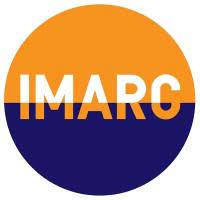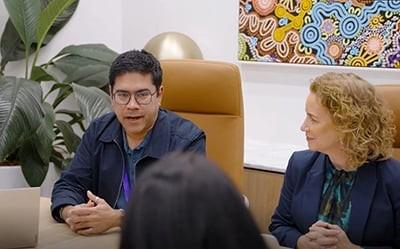
AI, digital twins and mining’s need for speed

by Richard Roberts, Editorial Director, Beacon Events
Paul Canterbury sees a growing need to do more with less – scarcer energy, water, capital, skilled and experienced people – as a powerful driver of mining’s increased use of advanced digital twin and spatial computing technologies. But DXC Technology’s head of digital evolution in mining says the most fundamental change agent will be time.
“Exploration needs to be faster. Building projects needs to be faster. Operations need to get more out of the ground more quickly,” he says.
“How do we speed things up? We need new, safe ways of driving efficiency.
“Think about exploration today. You go out in the field, drill some holes, take the drill cores back to a location for analysis. The hit rate is said to be less than 1% in terms of finding what is being sought. But spectral analysis is upping that hit rate significantly – to maybe 70%. That spectral analysis uses huge amounts of satellite data. How do you visualise that in new ways?
“Spatial computing is a great way to do that.
“We’re no longer looking at a screen and typing on a keyboard. We’re immersing ourselves in the digital representations of the worlds that we’re managing and supporting to have a better understanding of the operational reality of what’s happening day-to-day.
“Coupled with the current acceleration in the adoption of AI there are significant productivity benefits that can flow from the adoption of digital twins and spatial computing.”
Canterbury has headed US-based DXC Technology’s Global Mining Innovation Centre for the past year. He says the hub, backed by DXC’s large ecosystem of partners, brings together technologies that are materially impacting mining and other industries. DXC has been working with mining organisations for the past 25 years.
Canterbury says mining’s “great crew change” saw the establishment of remote operations centres to cater for a generation of people who were more comfortable working in cities than on remote project and mine sites. The operations bases also centralised information flows and created more collaborative task-sharing and problem-solving environments.
“I think the biggest shift we’re seeing in mining’s digital transformation is the integration of data,” Canterbury says.
“Our job is to expose data in your organisation in new ways for you to make faster decisions and also be able to determine what strategic risks or opportunities might be in your organisation as a consequence of that.

Head of DXC Technology’s Global Mining Innovation Centre, Paul Canterbury
“Typically data is in silos a lot of the time. Now there are suddenly new standards where AI can liberate data from organisations and AIs can talk to each other to get work done. The surfacing of data in organisations and the ability to take action in real time as a consequence of that, all driven by AI, is going to be a game changer for digital transformation.
“I do think this enhanced immersive digital technology is one of the things that’s going to amplify that again. It is providing us with a way to work more collaboratively with site operations and maintenance personnel, where someone can be with you virtually on a site doing work, to achieve better, safer and faster outcomes.
“Mining is starting to explore new ways of working that we’re seeing in adjacent industries – in construction, engineering and medicine.
“DXC works with a number of mining companies on digital twins for rehabilitation, investor relations in acquisitions, training and remote safety solutions.
“When you’re building things how do you speed up your permitting process and your regulatory requirements to get those moving? The best way is to visualise data in ways that allow people to make decisions more quickly. So I think it’s going to help accelerate in ways like that as well.
“It’s also becoming increasingly difficult to recruit engineering and technical staff. There aren’t enough people coming through the tertiary system. There is an aging workforce that is leaving the industry. How do you ensure you can continue to grow your organisation with a shrinking workforce over time? It’s one of the factors at the heart of mining’s productivity challenge.
“Some of the work that we’re doing is to say, how do we reimagine what the workforce of the future will be doing and how they will be working in this new world?
“The remote operations centre of the future, for example, where you have an unlimited digital canvas that you can work on to bring in the information that you need and respond to what’s happening in your environment in real time. We are doing some pilot studies with mining companies to help them understand that.”
Canterbury will host a panel discussion at the upcoming IMARC 2025 conference in Sydney on mining’s digital evolution and the platforms being delivered to facilitate transformational change.
DXC will also present state-of-the-art digital twin applications.
“Imagine a three-dimensional view of your mine site where you can track assets moving,” Canterbury says. “We’ll actually show this at IMARC. You can track assets moving and you can zoom right into those assets to have a look at them.
“Imagine the training capability that provides.
“If you instantiate in a digital twin a virtual haul truck that somebody can drive around your mine to make sure that they are comfortable with the safety of the environment before they actually drive it for real. Or an explosive hole-charging rig: rather than putting explosives in a hole during field training you can do it in that virtual space where it’s safe and you can be shown the ropes before you actually get out there and do it.
“This is about productivity and safety.
“The industry literally has mountains to move to extract the minerals the world needs for the energy transition.
“The world needs the industry to move faster.”
For more information, please visit the IMARC Website.
About IMARC: Collaborating on trends in mining, investment and innovation towards a sustainable future
IMARC is the premier gathering for the most influential minds in the mining industry, a dynamic hub where ideas ignite, and inspiration flows – it is the ultimate meeting ground for global industry leaders. As Australia’s largest and most significant mining event, IMARC attracts over 9,000 decision-makers, industry leaders, policymakers, investors, commodity buyers, technical experts, innovators, and educators from more than 120 countries. For three action-packed days, attendees will engage in cutting-edge learning, forge valuable deals, and experience unparalleled networking opportunities.
MORE or "UNCATEGORIZED"
Doubleview Extends High-Grade Domains at Hat: H099 Returns 438m of 0.40% CuEq Including 52m of 1.02% CuEq, Expanding Mineralization Envelope Around Conceptual Pit Vertically and Laterally
Doubleview Gold Corp. (TSX-V: DBG) (OTCQB: DBLVF) (FSE: 1D4) is pleased to announce assay results f... READ MORE
Cosa Closes Upsized C$7.5 Million Private Placement
Cosa Resources Corp. (TSX-V: COSA) (OTCQB: COSAF) (FSE: SSKU) is pleased to announce that it ... READ MORE
Americas Gold and Silver Closes US$132.25 Million Bought Deal Financing
Americas Gold and Silver Corporation (TSX: USA) (NYSE American: USAS) is pleased to report that it h... READ MORE
1911 Gold Closes C$23 Million "Best Efforts" Life Offering & Private Placement and Provides Corporate Updates
1911 Gold Corporation (TSX-V: AUMB) (FRA: 2KY) is pleased to announce that it has completed its prev... READ MORE
Endeavour Silver Completes US$350 Million Offering of Convertible Senior Notes
Endeavour Silver Corp. (NYSE: EXK) (TSX: EDR) announced today the closing of its previously announce... READ MORE












